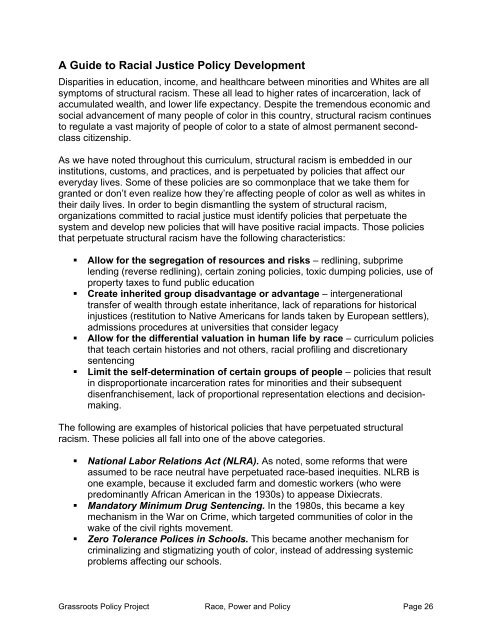Institutional Racism
Institutional Racism
Institutional Racism
Create successful ePaper yourself
Turn your PDF publications into a flip-book with our unique Google optimized e-Paper software.
A Guide to Racial Justice Policy Development<br />
Disparities in education, income, and healthcare between minorities and Whites are all<br />
symptoms of structural racism. These all lead to higher rates of incarceration, lack of<br />
accumulated wealth, and lower life expectancy. Despite the tremendous economic and<br />
social advancement of many people of color in this country, structural racism continues<br />
to regulate a vast majority of people of color to a state of almost permanent secondclass<br />
citizenship.<br />
As we have noted throughout this curriculum, structural racism is embedded in our<br />
institutions, customs, and practices, and is perpetuated by policies that affect our<br />
everyday lives. Some of these policies are so commonplace that we take them for<br />
granted or don’t even realize how they’re affecting people of color as well as whites in<br />
their daily lives. In order to begin dismantling the system of structural racism,<br />
organizations committed to racial justice must identify policies that perpetuate the<br />
system and develop new policies that will have positive racial impacts. Those policies<br />
that perpetuate structural racism have the following characteristics:<br />
" Allow for the segregation of resources and risks – redlining, subprime<br />
lending (reverse redlining), certain zoning policies, toxic dumping policies, use of<br />
property taxes to fund public education<br />
" Create inherited group disadvantage or advantage – intergenerational<br />
transfer of wealth through estate inheritance, lack of reparations for historical<br />
injustices (restitution to Native Americans for lands taken by European settlers),<br />
admissions procedures at universities that consider legacy<br />
" Allow for the differential valuation in human life by race – curriculum policies<br />
that teach certain histories and not others, racial profiling and discretionary<br />
sentencing<br />
" Limit the self-determination of certain groups of people – policies that result<br />
in disproportionate incarceration rates for minorities and their subsequent<br />
disenfranchisement, lack of proportional representation elections and decisionmaking.<br />
The following are examples of historical policies that have perpetuated structural<br />
racism. These policies all fall into one of the above categories.<br />
" National Labor Relations Act (NLRA). As noted, some reforms that were<br />
assumed to be race neutral have perpetuated race-based inequities. NLRB is<br />
one example, because it excluded farm and domestic workers (who were<br />
predominantly African American in the 1930s) to appease Dixiecrats.<br />
" Mandatory Minimum Drug Sentencing. In the 1980s, this became a key<br />
mechanism in the War on Crime, which targeted communities of color in the<br />
wake of the civil rights movement.<br />
" Zero Tolerance Polices in Schools. This became another mechanism for<br />
criminalizing and stigmatizing youth of color, instead of addressing systemic<br />
problems affecting our schools.<br />
Grassroots Policy Project Race, Power and Policy Page 26

















